Sedimentation Tanks for Treating Rainwater: CFD Simulations and PIV Experiments
Abstract
1. Introduction
2. Materials and Methods
2.1. CFD Simulations
2.2. PIV Tests
3. Results
4. Conclusions
- −
- In the tested models, greater turbulence is observed in the upper parts of the sedimentation tanks. This may have a positive effect on the sedimentation and deposition of solid particles at the bottom of the sedimentation tanks;
- −
- In the standard sedimentation tank OS, at high velocities of the dosed liquid, solid particles may wash out and get directly into the outlet pipe;
- −
- The tests were carried out for a single-phase model, and therefore further analyzes for multiphase systems are suggested in order to be able to fully visualize the operation and efficiency of the evaluated apparatus models;
- −
- The obtained simulation results were experimentally verified, and it was observed that the simulation was similar to the actual behavior of the liquid flowing through the apparatus;
- −
- Analysis with the use of the PIV technique is a good non-invasive method for verifying the correctness of CFD simulations, and also for conducting flow tests and visualization of the liquid flow through the apparatus.
Author Contributions
Funding
Institutional Review Board Statement
Informed Consent Statement
Data Availability Statement
Acknowledgments
Conflicts of Interest
References
- Nikou, N.S.R.; Ziaei, A.N.; Ansary, H.; McDonough, J.M. Flow field investigation in a vortex settling basin using Acoustic Doppler Velocimetry and large eddy simulation. Water Environ. J. 2020, 35, 865–883. [Google Scholar] [CrossRef]
- Zawilski, T.; Grajewski, M.; Gruszka, P. Research on Water Purification in a STP Separator; Poznan University of Technology: Poznan, Poland, 2020. [Google Scholar]
- Nixor. Horizontal Sedimentation Tank, Model NIXOR-NO. Available online: www.nixor.pl/osadniki-poziome,19,pl.html (accessed on 15 August 2021).
- Shah, M.T.; Parmar, H.B.; Rhyne, L.D.; Kalli, C.; Utikar, R.P.; Pareek, V.K. A novel settling tank for produced water treatment: CFD simulations and PIV experiments. J. Pet. Sci. Eng. 2019, 182, 106352. [Google Scholar] [CrossRef]
- Kiss, K.; Patziger, M. Novel measurements in primary settling tanks of large municipal wastewater treatment plants. Environ. Sci. 2013, 1, 6–18. [Google Scholar] [CrossRef]
- Haba, R.L. Fat Separators and Separators. Available online: https://haba.pl/node/319 (accessed on 3 February 2020).
- Haba, R.L. Hydrocarbon Separators. Available online: https://haba.pl/node/339 (accessed on 30 December 2020).
- Patziger, M.; Günthert, F.W.; Jardin, N.; Kainz, H.; Londong, J. On the design and operation of primary settling tanks in state of the art wastewater treatment and water resources recovery. Water Sci. Technol. 2016, 74, 2060–2067. [Google Scholar] [CrossRef] [PubMed]
- Nawrot, N.; Wojciechowska, E. Review of the quality of sediments from rainwater drainage system and methods of classification of sediments deposited in rainwater receivers in the urban catchment area, in Polish. Inżynieria Morska I Geotech. 2017, 6, 276–281. [Google Scholar]
- Keshavarzi, A.R.; Gheisi, A.R. Trap efficiency of vortex settling chamber for exclusion of fine suspended sediment particles in irrigation canals. Irrig. Drain 2006, 55, 419–434. [Google Scholar] [CrossRef]
- De, A. Developments in Settling Studies in Sedimentation Process and Design of Settling Systems; Springer: Berlin/Heidelberg, Germany, 2017; pp. 5–35. [Google Scholar] [CrossRef]
- Sheddon, A. Cleaning water by settlement. J. Assoc. Eng. Soc. 1889, 477. [Google Scholar]
- Goula, A.M.; Kostoglou, M.; Karapantsios, T.D.; Zouboulis, A.I. A CFD methodology for the design of sedimentation tanks in potable water treatment: Case study: The influence of a feed flow control baffle. Chem. Eng. J. 2008, 140, 110–121. [Google Scholar] [CrossRef]
- He, Z.; Zhang, Y.; Wang, H.; Qi, L.; Yin, X.; Zhang, X.; Wen, Y. A novel model for the entire settling-thickening process in a secondary settling tank. Water Environ. Res. 2016, 88, 2228–2232. [Google Scholar] [CrossRef]
- Li, L.; Wang, P.; Ma, Y.; Wu, Y. Reducing sediment deposition on deflector in vortex settling basins. J. Irrig. Drain Eng. 2020, 146, 1–8. [Google Scholar] [CrossRef]
- Saneie, M.; Asefi, M.; Smaeeli, K. Experimental studies on increasing sedimentation efficiency of the vortex settling basin by using submerged vanes. J. Watershed Eng. Manag. 2013, 5, 224–232. [Google Scholar] [CrossRef]
- Yaseen, D.A.; Abu-Alhail, S.; Mohhamed, R.N. An experimental sedimentation tank for enhancing the settling of solid particles. J. Water Land Dev. 2021, 49, 63–73. [Google Scholar] [CrossRef]
- Tamayol, A.; Firoozabadi, B.; Ashjari, M.A. Hydrodynamics of secondary settling tanks and increasing their performance using baffles. J. Environ. Eng. 2010, 136, 32–39. [Google Scholar] [CrossRef]
- Weipeng, H.; Lianpeng, X.; Gorczyca, B.; Nan, J.; Shi, Z. Comparative analysis on flocculation performance in unbaffled square stirred tanks with different height-to-width ratios: Experimental and CFD investigations. Chem. Eng. Res. Des. Trans. Inst. Chem. Eng. Part A 2018, 132, 518–535. [Google Scholar]
- Athar, M.; Kothyari, U.C.; Garde, R.J. Distribution of sediment concentration in the vortex chamber type sediment extractor. J. Hydraul. Res. 2003, 41, 427–438. [Google Scholar] [CrossRef]
- Denk, V.; Dürholt, A. Experimental investigations of the unsteady rotating flow field in a cylindrical vessel. Exp. Fluids 1991, 12, 97–105. [Google Scholar] [CrossRef]
- Diakun, J.; Jakubowski, M. Simulation investigations of the effects of whirlpool dimensional ratios on the state of secondary whirls. J. Food Eng. 2007, 83, 106–110. [Google Scholar]
- Jakubowski, M.; Sterczyska, M.; Matysko, R.; Poreda, A. Simulation and experimental research on the flow inside a whirlpool separator. J. Food Eng. 2014, 133, 9–15. [Google Scholar] [CrossRef]
- Verrapen, J.P.; Lowry, B.; Couturier, M.F. Design methodology for the swirl separator. Aquac. Eng. 2005, 33, 21–45. [Google Scholar] [CrossRef]
- Matias, R.I.; Gianina, L.R.; Facundo, G.; Marcelo, G.C.; Melina, D.B.; Gerardo, B.B. Combined use of LS-PIV and CFD for the characterization of turbulent flow in the contact chamber of ‘COSTA AZUL’ wastewater treatment plant, Carlos Paz. J. Hydr. 2021, 23, 1083–1097. [Google Scholar] [CrossRef]
- Bridgeman, J.; Jefferson, B.; Jefferson, B.; Parsons, S.A. The development and application of CFD models for water treatment flocculators. Adv. Eng. Softw. 2010, 41, 99–109. [Google Scholar] [CrossRef]
- Wadnerkar, D.; Utikar, R.P.; Tade, M.O.; Pareek, V. CFD simulation of solid–liquid stirred tanks. Adv. Powder Technol. 2012, 23, 445–453. [Google Scholar] [CrossRef]
- Markowska, M.; Ochowiak, M.; Włodarczak, S.; Matuszak, M. The modified primary swirl sedimentation: Tanks in waste liquids treatment plant: Liquid viscosity effect. Arch. Environ. Prot. 2020, 46, 42–48. [Google Scholar] [CrossRef]
- Dufresne, M.; Vazquez, J.; Terfous, A.; Ghenaim, A.; Poulet, J.B. Experimental investigation and CFD modelling of flow, sedimentation and solids separation in a combined sewer detention tank. Comput. Fluids 2009, 38, 1042–1049. [Google Scholar] [CrossRef]
- He, P.; Salcudean, M. A numerical method for 3D viscous incompressible flows using non-orthogonal grids. Int. J. Numer. Methods Fluids 1994, 18, 449–469. [Google Scholar] [CrossRef]
- Mohanarangam, K.; Stephens, D.W. CFD modelling of floating and settling phases in settling tanks. In Proceedings of the Seventh International Conference on CFD in the Minerals and Process Industries, CSIRO, Melbourne, Australia, 9–11 December 2009. [Google Scholar]
- Kuok, K.K.; Chiu, P.C. Application of particle image velocimetry (PIV) for measuring water velocity in laboratory sedimentation tank. IRA-Int. J. Eng. Technol. 2017, 9, 16–26. [Google Scholar] [CrossRef][Green Version]
- Markowska, M.; Kruszelnicka, I.; Ginter-Kramarczyk, D.; Krupińska, A.; Ochowiak, M.; Fus, A.; Okupniak, K.; Woziwodzki, S.; Włodarczak, S.; Matuszak, M. Experimental verification of CFD simulation of the process of separation of suspended particles in a modified swirl setting tank. Instal 2018, 12, 63–66. [Google Scholar]
- Ecol-Unicon. Vortex Settling Tank, EOW-1. Available online: https://ecol-unicon.com (accessed on 15 August 2021).
- McCorquodale, J.A.; Yuen, E.M.; Vitasovic, Z.; Samstag, R. Numerical simulation of unsteady conditions in clarifiers. Water Poll. Res. J. Can. 1991, 26, 201–222. [Google Scholar] [CrossRef]
- McCorquodale, J.A.; Zhou, S. Effects of hydraulic and solids loading on clarifier performance. J. Hydr. Res. 1993, 31, 461–477. [Google Scholar] [CrossRef]
- Zhou, S.; McCorquodale, J.A.; Godo, A.M. Short circuiting and density interface in primary clarifiers. J. Hydr. Eng. 1994, 120, 1060–1080. [Google Scholar] [CrossRef]
- Zawilski, T.; Dudek, L. Analysis of Particle Motion in Standard and Vortex Settling Tanks. Master’s Thesis, Poznan University of Technology, Poznan, Poland, 2021. [Google Scholar]
- Shamber, D.R.; Larock, B.E. Numerical analysis of flow in sedimentation basins. J. Hydr. Div. 1981, 107, 575–591. [Google Scholar] [CrossRef]

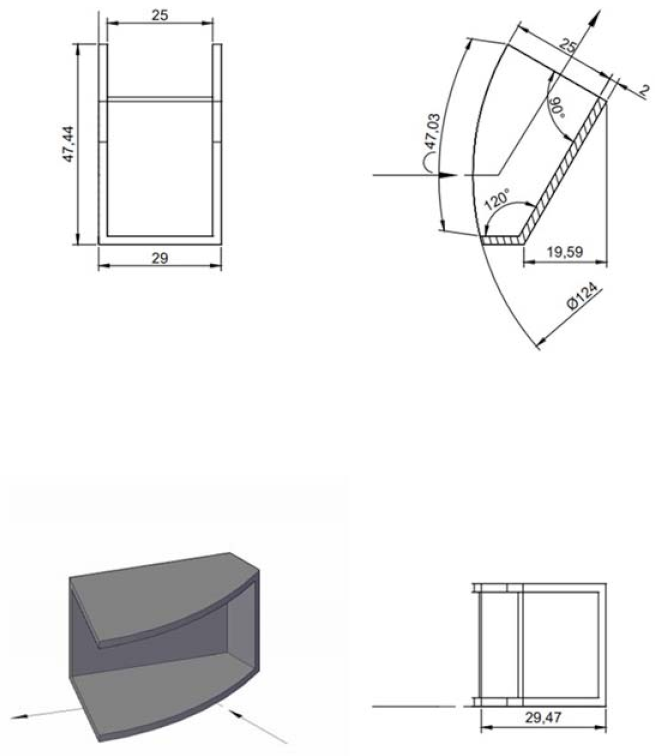
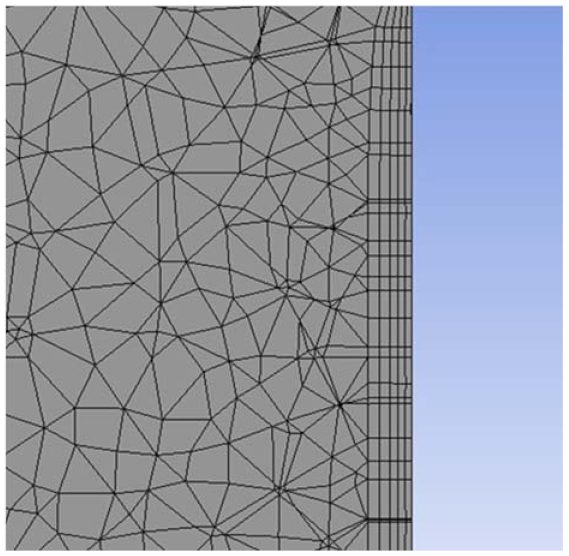

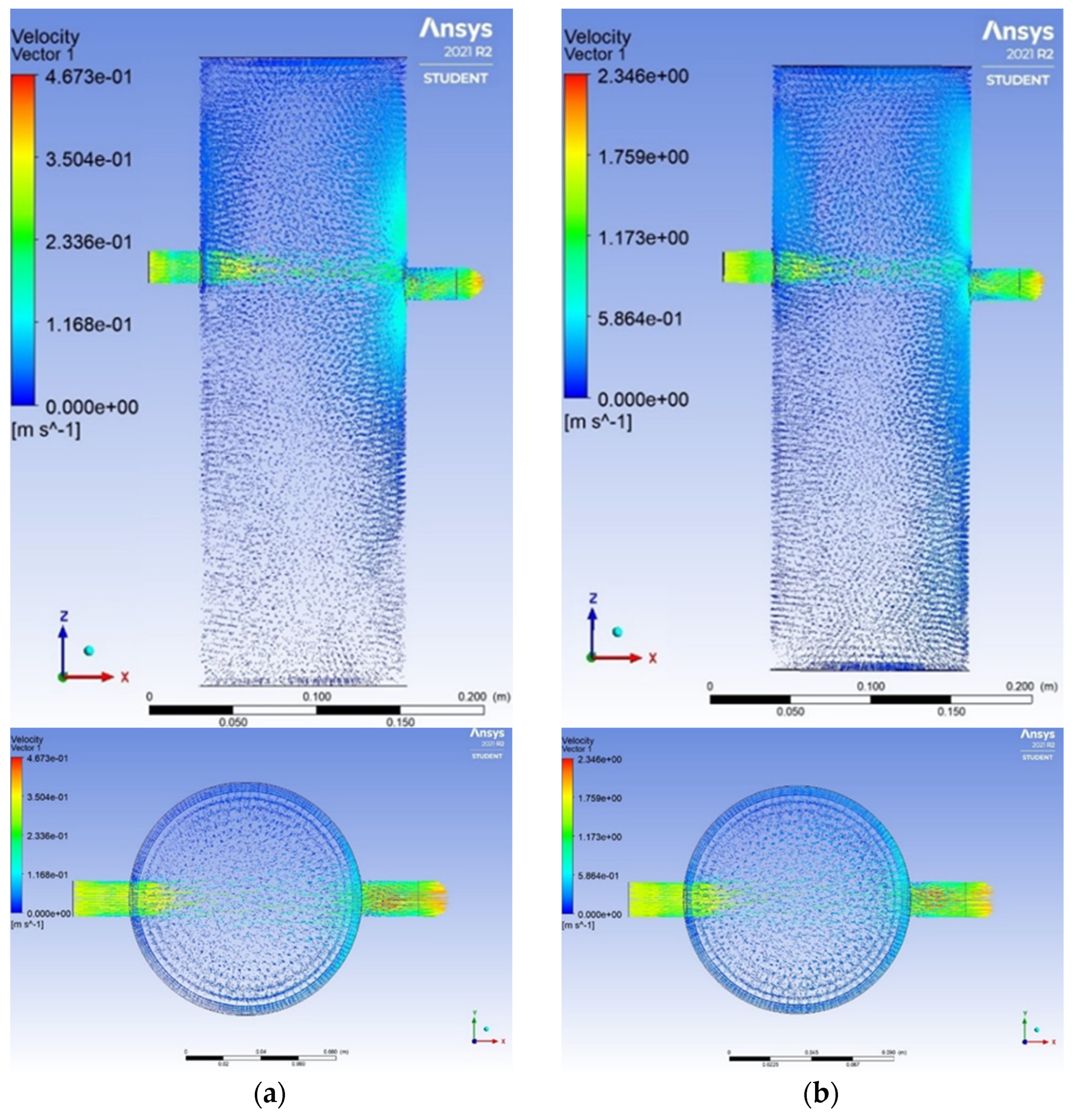


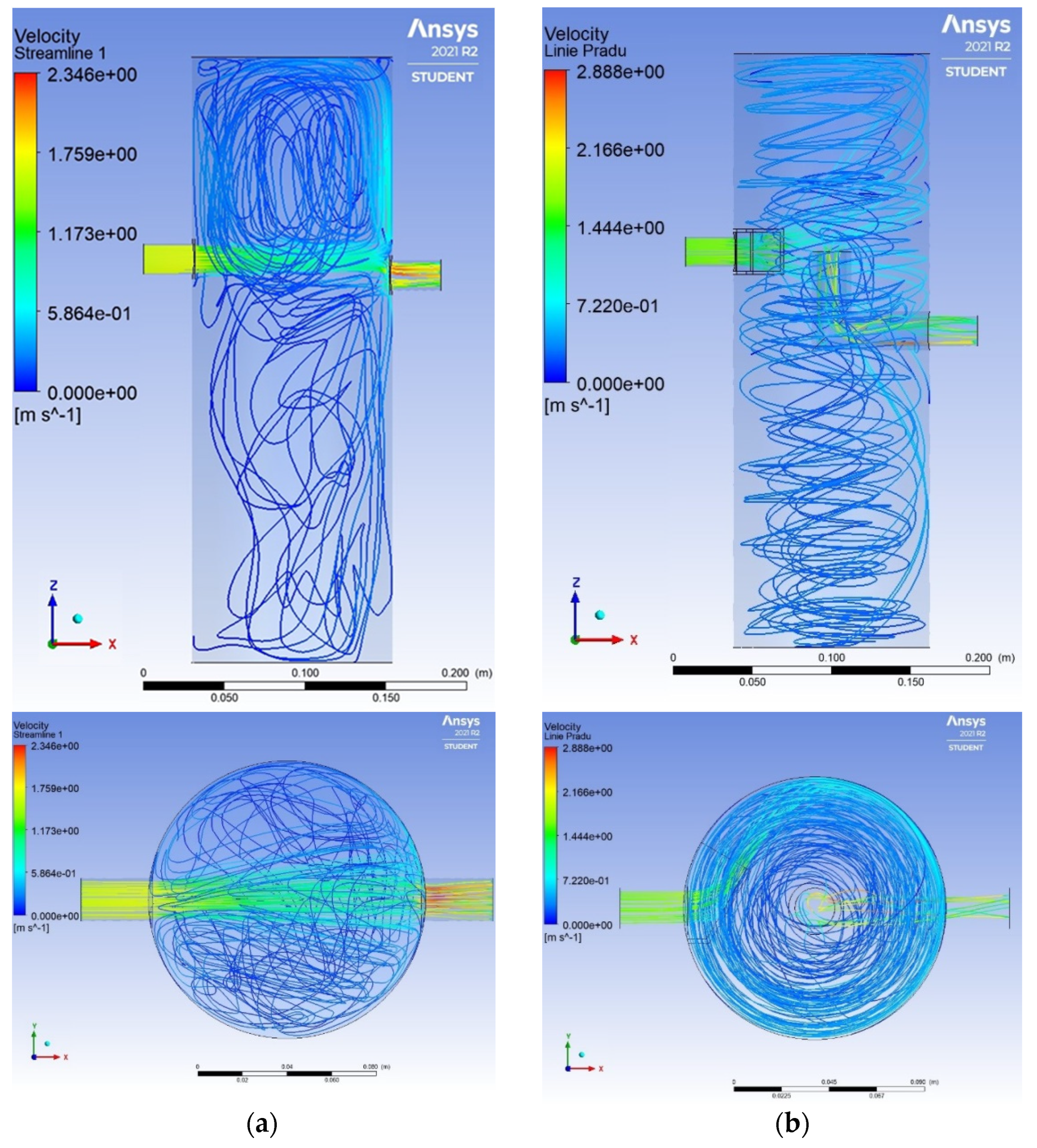

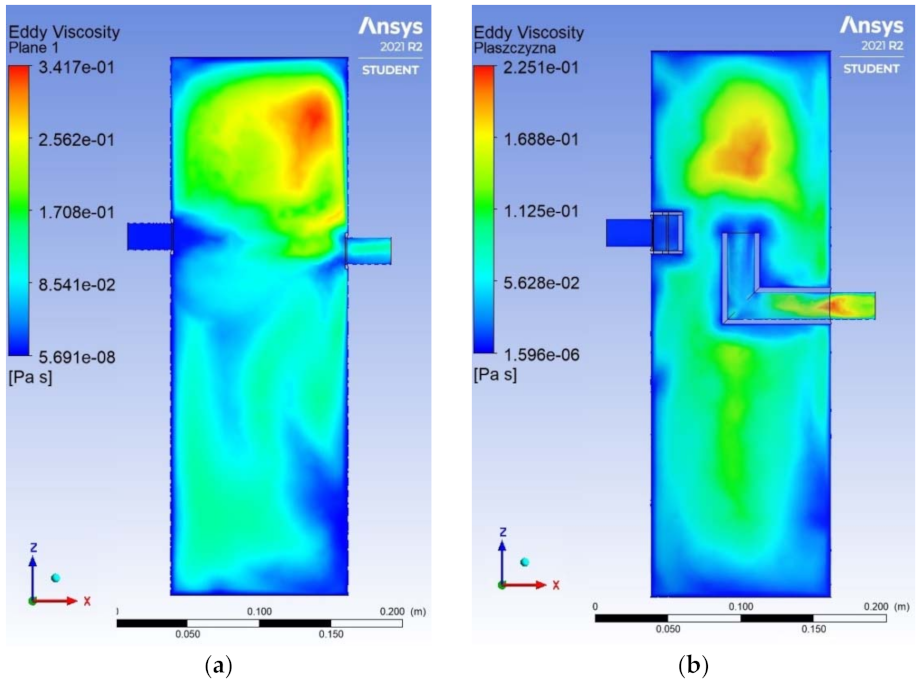
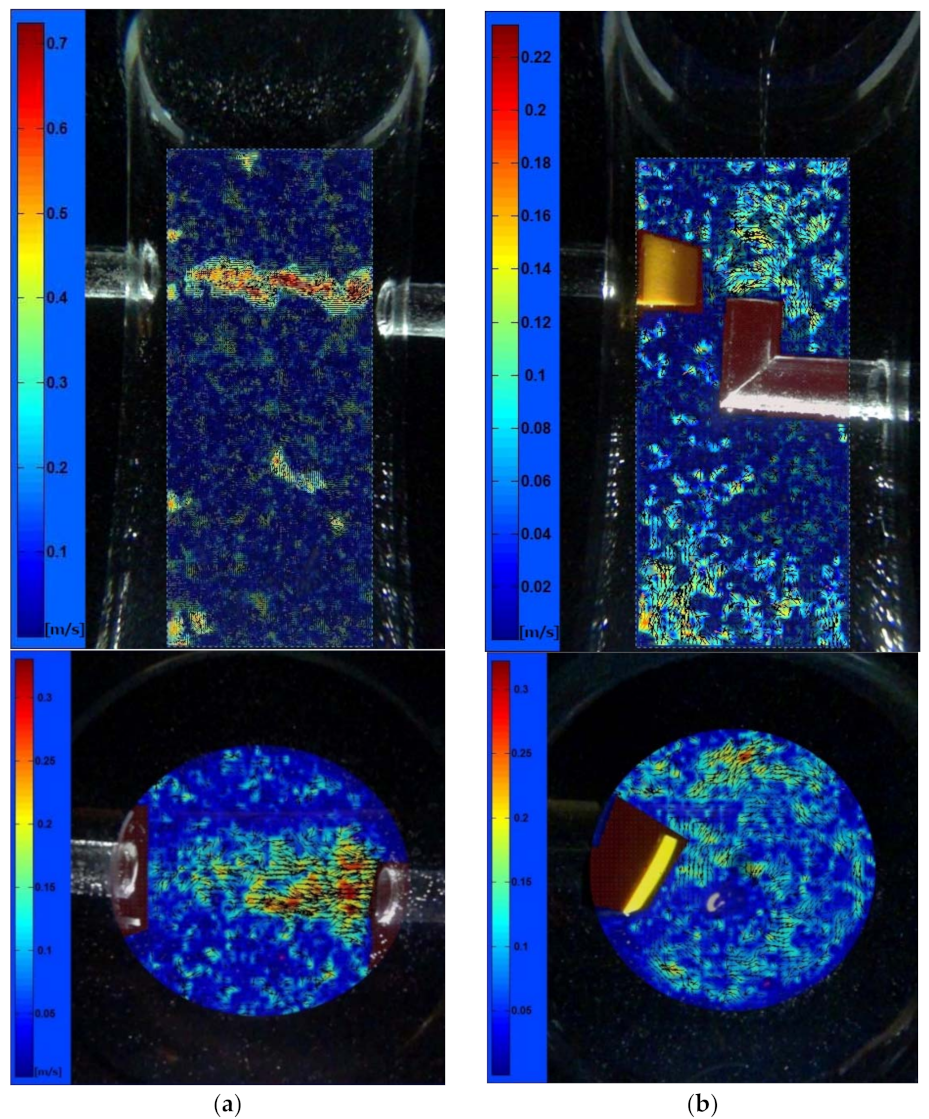
| Parameter | Value |
|---|---|
| Continuous phase | Water |
| Water density | 998.2 kg/m3 |
| Water viscosity | 0.001003 kg/(m·s) |
| Flow velocity | v1 = 0.3 m/s, v2 = 0.6 m/s, v3 = 1.0 m/s, v4 = 1.3 m/s, v5 = 1.6 m/s |
| Velocity of the Dispensed Liquid vi (m/s) | (m/s) for OS (P) | (m/s) for OS (G) | (m/s) for OW (P) | (m/s) for OW (G) |
|---|---|---|---|---|
| 0.294 | 0.268 | 0.160 | 0.047 | 0.068 |
| 0.588 | 0.084 | 0.181 | 0.058 | 0.063 |
| 0.980 | 0.253 | 0.169 | 0.060 | 0.066 |
| 1.274 | 0.263 | 0.095 | 0.067 | 0.080 |
| 1.568 | 0.108 | 0.104 | 0.062 | 0.077 |
Publisher’s Note: MDPI stays neutral with regard to jurisdictional claims in published maps and institutional affiliations. |
© 2021 by the authors. Licensee MDPI, Basel, Switzerland. This article is an open access article distributed under the terms and conditions of the Creative Commons Attribution (CC BY) license (https://creativecommons.org/licenses/by/4.0/).
Share and Cite
Czernek, K.; Ochowiak, M.; Janecki, D.; Zawilski, T.; Dudek, L.; Witczak, S.; Krupińska, A.; Matuszak, M.; Włodarczak, S.; Hyrycz, M.; et al. Sedimentation Tanks for Treating Rainwater: CFD Simulations and PIV Experiments. Energies 2021, 14, 7852. https://doi.org/10.3390/en14237852
Czernek K, Ochowiak M, Janecki D, Zawilski T, Dudek L, Witczak S, Krupińska A, Matuszak M, Włodarczak S, Hyrycz M, et al. Sedimentation Tanks for Treating Rainwater: CFD Simulations and PIV Experiments. Energies. 2021; 14(23):7852. https://doi.org/10.3390/en14237852
Chicago/Turabian StyleCzernek, Krystian, Marek Ochowiak, Daniel Janecki, Tomasz Zawilski, Leszek Dudek, Stanisław Witczak, Andżelika Krupińska, Magdalena Matuszak, Sylwia Włodarczak, Michał Hyrycz, and et al. 2021. "Sedimentation Tanks for Treating Rainwater: CFD Simulations and PIV Experiments" Energies 14, no. 23: 7852. https://doi.org/10.3390/en14237852
APA StyleCzernek, K., Ochowiak, M., Janecki, D., Zawilski, T., Dudek, L., Witczak, S., Krupińska, A., Matuszak, M., Włodarczak, S., Hyrycz, M., & Pavlenko, I. (2021). Sedimentation Tanks for Treating Rainwater: CFD Simulations and PIV Experiments. Energies, 14(23), 7852. https://doi.org/10.3390/en14237852











